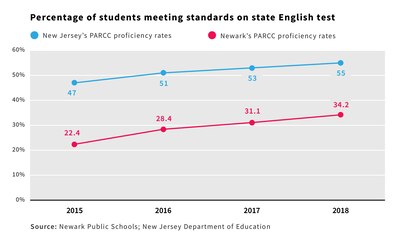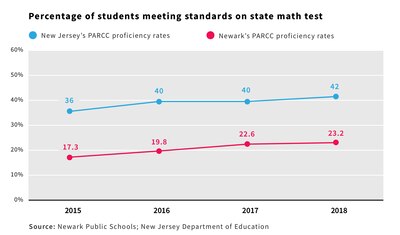Newark students made progress on the state English tests this spring, while growth stalled on the math tests, according to results released by the district. The results provide a new baseline that the district, which is back under local control after decades of state oversight, will likely be judged against in coming years.
Just over 34 percent of Newark students who took the 2018 PARCC English tests met or exceeded state expectations — a 3.1 percentage point increase over the previous year. Students in grades 3 to 11 took the computerized tests; every grade except for fifth and eighth made gains in English.
In math, 23.2 percent of students hit the state’s benchmark. That is 0.6 percentage points higher than in 2017 — a smaller growth rate than in previous years. The results were uneven: While some grades made gains, students in grades 3, 6, and 8 saw declines, as did students who took the geometry test.

Statewide, 55 percent of students met grade-level expectations in English and 42 percent did so in math. Students must score at a level 4 or above on a 1-5 scale to be considered performing on grade level.
In February, after 22 years of state control, Newark’s local school board was put back in charge of the district, just weeks before students sat for the tests. The results will now become the yardstick against which observers will measure student progress under local control and assess the new superintendent, Roger León, a veteran Newark education who took over in July.
“We have a lot of work to do,” León said at a board meeting in August where officials shared some highlights from the results. (Chalkbeat filed a public-records request to get the district-wide pass rates.)
In a recent public radio interview, León added that the test scores show that teaching needs to improve.
“The instruction in the classroom can’t be the same,” as it has been, he said on WBGO. “Because our student achievement data is suggesting that that’s not really good.”

State policymakers are currently debating the future of the PARCC tests, which students first took in 2015. Gov. Phil Murphy has vowed to replace the controversial tests, but some lawmakers have expressed concerns about his plan.
The state sent this year’s PARCC results to districts, which have shared them with families, but it has not yet posted them online. Last year, they were available to the public on Sept. 28. A state education department spokesman said Wednesday that he expects the school and district-level results to be posted “in a matter of days.”
After the results were published last year, Newark sent out a press release touting the district’s progress. The release noted that Newark made larger gains in math and English than the state overall. This year, the district’s gains were larger than the state’s in English but smaller than the state’s in math.
Newark’s test scores have become the site of a proxy battle between critics and defenders of the controversial policies that transformed the district in recent years. Under former state-appointed superintendents Cami Anderson and Christopher Cerf, some neighborhood schools were shuttered, more charter schools were opened, and a new teachers contract that tied teacher pay partly to student test scores.
Last year, a team of Harvard researchers tried to measure the impact of those changes. They found that Newark students’ annual growth on the state tests initially declined after the reforms kicked off in 2011. By 2016, however, students were making greater gains in English than they had before the reforms. In math, their growth was no better or worse than before the changes.
Whatever factors drove Newark’s test scores to where they are today, Superintendent León will now be expected to move them higher. Indeed, along with perfect attendance, León has set a goal of every student passing the state tests — an impossibly high bar that no large urban district has ever cleared.
As León tries to boost scores, he must contend with wide achievement gaps between groups of students. For instance, on the English tests, white students outperformed black students by 26 percentage points, general-education students outperformed special-education students by 29 points, and English-proficient students outperformed those still learning the language by 26 points.
“We actually have a strategy on how to reduce the gap and improve achievement,” León said at the Aug. 28 board meeting. “We’re not afraid of the data.”
Graphics by Sam Park.

